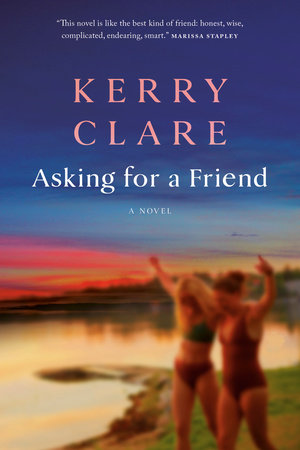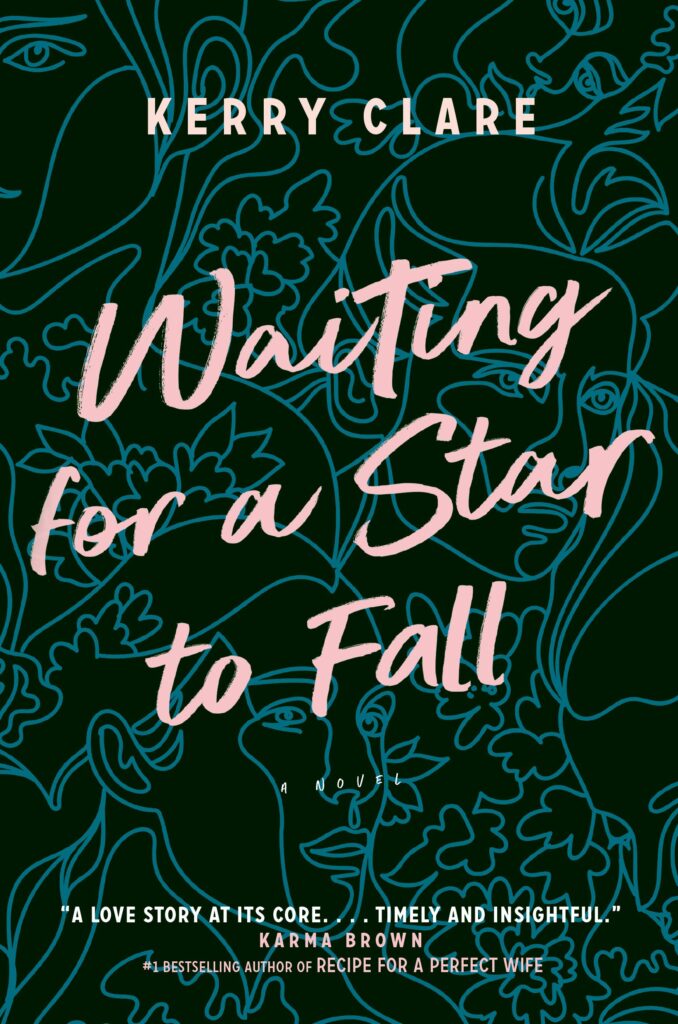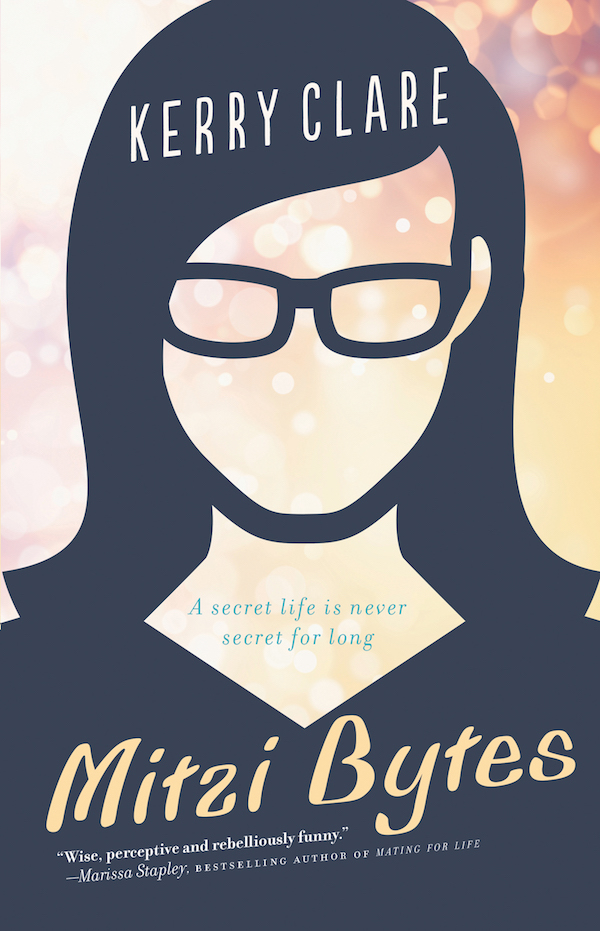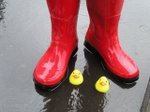September 13, 2018
Late Breaking, KD Miller

So, if we’re talking about remarkable things, let’s start with the obvious one: the cover. How many other book covers this season feature a naked man drinking milk? I’ll wait. And in the meantime, we can talk about “Refrigerator,” by Alex Colville, which on the advanced copy of K.D. Miller’s Late Breaking that I read was less subtle than it is on the finished version, above. Which meant I felt kind of conspicuous reading it in the dentist’s waiting room the other day, but then I got over it, because the book is so excellent that the penis on the cover quickly ceases to be the point.
And so too does this collection’s conceit, which is that each story is inspired by an Alex Colville painting. Which is not to say that this way of collecting stories into a book is not compelling—absolutely not. It’s an fascinating idea that adds additional texture to Colville’s work, and the stories themselves are similarly absorbing, both ordinary and extraordinary at once, and disturbed by an uncanny strangeness—like the gun on the table, a horse on the train track. Each story is preceded by an image of the painting that inspired it, and the connections between the works are surprising and illuminating both ways.
But this too is eclipsed by something far more central to the text when we talk about the collection: which is that the stories themselves are incredibly good. The first story (inspired by “Kiss With Honda”) is about a widower whose relationship with wife was tainted by a secret she never knew he realized and was never able to explain before he dies, and then he goes to visit her grave, which leads to an act of violence that comes out of nowhere—and suddenly we realize that these stories have teeth, and claws. The second story is about Jill, an older woman whose novel has been shortlisted for an award, and she’s touring with a motley crew of other nominated authors, all the while reflecting on the sex-lives of septuagenarians and the relationship (and heartache) that inspired her work. The third story, “Witness,” takes Colville’s painting “Woman on Ramp” literally—Harriet is the woman on the ramp, and after coming out of the lake and into her cottage, she finds an arm around her neck and something sharp against her back. “Olly Olly Oxen Free” is about the marriage between a woman and her husband, a failed novelist, intersected with story of an older woman in her book club who still carries the pain of a traumatic childhood event. In “Octopus Heart,” a lonely man (who turns out to be the one who broke Jill’s heart in the second story, five years before) feels the first intimate collection of his life with an octopus from the aquarium. In “Higgs Bosun,” a woman (whose son is married to Harriet’s son from a previous story) thinks about the ways she’s tried and failed to hold the world and her family together. In “Lost Lake,” the family from “Olly Olly…” are away at an isolated resort where their daughter seems to be visited by sinister supernatural forces. “Crooked Little House” takes us back to the widower from the first story, and his neighbour (who is the estranged daughter of the octopus man), and their friendship with another man who is trying to make a clean start after twenty-five years in prison. For the murder of a woman who, we realize in the next story, was a friend of Harriet and Jill, all of them meeting one summer long ago—and this story begins with a wonderful scene in a locker-room, older women squeezing into their bathing suits without regard for their naked bodies. “Have we all just given up? Harriet thinks, hanging her suit on a hook in one of the shower stalls and rinsing down. Or is this wisdom?”
These are all rich and absorbing stories on their own, but even richer for how they also inform each other. Eventually I would be making a chart in the back of the book to figure out all the surprising connections, including the final story, about the murdered girl’s mother who was also author of a book about octopuses that preoccupied a character in a previous story. Similar to my friend Rebecca Rosenblum’s work, K.D. Miller’s fiction seems to conjure whole worlds, with characters who seem to walk off the page and who—one has no doubt—continues in their adventures even when their stories are finished. We get glimpses of these people, but they’re like the tip of an iceberg and there’s so much more going on beneath the surface. Which is something you could say about the people in Colville’s paintings too, and about each of these stories themselves, compelling and disturbing, and impossible to look away from, creating the most terrific momentum.
September 12, 2018
Unabashed

I remember the first time I had courage to stand up and confront an anti-abortion protester. It was the summer of 2015 and I’d just dropped off Harriet at day camp, and the year before I’d published an essay about how becoming a mother taught me everything I knew (and was grateful for) about my abortion. Which meant that I’d thought about abortion a lot, and was comfortable talking about mine in public, and had a lot to say about my experiences, actually. Even though I usually shy away from conflict, and don’t get off on debate just for the fun of it (because, unlike a lot of anti-abortion protesters, it’s my bodily autonomy we’re talking about. These ideas, for me, aren’t abstract, and I will probably cry). These people are able to dominate the abortion conversation like they do because most of us don’t know how to talk about our abortions in public (and why should we have to? We don’t require men to issue public defences of their prostate surgeries). But I’d had enough to having these people be the loudest people when we talk about abortions, of their taking advantage of civility and politeness to scream the loudest. I was ready to talk, and so I did, and it was exhilarating, and terrifying, and very empowering to be able to tell this young man holding a sign: “I KNOW MORE ABOUT THIS THAN YOU DO. YOU’VE GOT A SCRIPT, BUT THIS IS MY LIFE STORY.”
Unfortunately, however, arguing with these zealots gets you nowhere, and while it feels good not to be silent, these conversations are always a waste of energy. So I had this idea that maybe I could make a sign, and luckily I’m married to a standup guy who makes signs for a living (among other talents) and so I said to him, “What if you made me a pro-choice sign I could fold up and carry in my purse? So I could have it on my person at all times in case of an emergency, and be there are represent and have my voice heard, but not have to talk to these abusive nefarious creeps that get off on turning women’s private experiences into public spectacle?” And my husband said okay, and he designed my sign and had it printed, and I’ve been carrying it around for nearly two years now, but there’s that rule about only ever having a thing when you don’t need it. I’ve not seen anti-abortion protestors since the Christmas I found my “My Body My Choice” sign under the tree. Which I wasn’t sorry about—maybe the sign was like some sort of repellant, and in that case, good riddance. I had my sign and women in my neighbourhood were free to walk about the streets without the abuse of gory and misleading photos of fetuses.
But no repellant lasts forever, it seems, because today I got word of the usual suspects setting up shop a few blocks from my house. So I walked over there, where a respectable counter-protest had been set up by Students for Choice and I was honoured to join them with my little sign (and my actual life experience, which is short on the ground on the pro-life side). And there I stood for an hour as people said thank you and others rolled their eyes at the display, and men stood behind me having rhetorical arguments on the matter of my bodily autonomy and didn’t seem anything ironic about that. As I said so beautifully in all-caps on Twitter: “Do you know what’s more arbitrary than Canada’s lack of an abortion law so that abortion is a decision between a woman and her doctor? AN ABORTION LAW DECIDED BY SOME RANDOM GUY ON THE SIDEWALK.”
This morning I read Anne Kingston’s article about plans afoot by the anti-abortion movement to make their cause a political issue everywhere, and it’s terrifying. It’s terrifying, because the most of us are going to continue to be civil and polite and let them continue to dominate the discourse with misrepresentation and lies—all the while our reproductive rights are eroded. But my daughters—who would not exist were it not for abortion and the choices I was free to make—deserve to have the same freedoms that I was lucky enough to be able to take for granted. And it’s not even just about them, or about abortion either—THREAD, as they say: “Reproductive justice is about bodily autonomy, it’s linked to racism and immigration and incarceration, it’s about classism and supremacy, it’s all connected to climate change and accessibility and colonialism…” writes Erynn Brook.
Reproductive justice is linked to everything, and it’s about standing up and speaking out for our rights right now. As unabashed as we want to be. About this, there is no choice—it has never been more important.
September 11, 2018
I am a swimmer

What I have to show for my last decade in athletics is not a whole lot—I once signed up for ten yoga classes but only went to one, and we still have the evidence of the running shoes my husband bought me when I decided to take up jogging that show remarkably little wear. Which is just two examples, and narratively anti-climactic, but it underlines the point I’m trying to make: I dislike most forms of exercise so much that I rarely quit them, because I’d have to join them first. Not doing things I dislike doing is pretty much the cornerstone of my approach to being alive: I don’t want to push through the pain, or feel the burn. If being miserable, even for limited periods of time, is a pre-requisite for physical activity, than take my name off the list. For a while I made do with a stationary bicycle, because while riding it at least I could read.
But now—like the shoes, and like the yoga passes nearly a decade expired, the stationary bicycle sits unused—draped with winter coats in an upstairs closet. It’s been at least two years since I’ve sat upon its little seat and spun its futile wheels into nowhere—but not for the reason you might be thinking. Oh, no. Because it’s also been two years now since I purchased a membership to the university athletic centre near my house. A membership I bought (inspired by Lindsay) just after getting a raise at my job and therefore being able to afford to put my youngest daughter in full-day preschool, which left time in the day for some kind of physical activity. I would go swimming, I decided. Maybe this would be a thing I could do, and I wouldn’t quit, because it wouldn’t be awful.

And it wasn’t, and I didn’t. And in the next few days, I will renew my membership again. Because I love it, swimming. I love it so much, I get up early in the morning to do it, much to the surprise of the people who know me, because it’s the only thing I’ve ever gotten out of bed for, and before 7am either. Four days a week (but not Friday, because on Friday everyone at rec swim is crammed into half of the 50 metre pool—the long half and not the short half—and it’s crowded and unpleasant) I wake up at 6:50 am and wriggle into my bathing suit, which is set out with my towel. Throw on clothes over top and rush to the pool, where I’m in the water by 7:15, and I swim for half an hour. During which I think, catalogue anxieties, solve plot problems, compose blog posts, try to remember all the verses to “American Pie,” and swim back and forth in the medium lane. Which is so my speed—the medium lane. It’s where I like to be.
I’ve loved swimming for a long time—I was lucky to have a pool in my backyard when I was growing up, and so even though I failed Bronze Cross twice because I couldn’t do the timed swim, I recall spending ages under water, turning somersaults, leaping high, partaking in an agility I did not partake in on dry land. When I lived in England, I longed for lakes, and once went swimming in a pond just to get my fix. One day on holiday in 2004, Stuart and I jumped into a hotel pool and discovered after two years together that we both liked swimming a lot, so much so that later in the week we’d jump into another hotel pool even though it was green, and I’d get a rash—me getting a rash will become a running theme here. And when I was pregnant with Harriet, I worked at the university, and went swimming every day on my lunch hour, delighting in the freedom of movement, and of floating suspended the way my baby was—the very first thing we ever did together.
But it’s hard to fit swimming into a busy life. For a long time, swimming was a special occasion, and I started buying expensive mail-order movie star bathing costumes to better suit my weird-postpartum body. But the thing that no one tells you about movie star bathing suits is that when you wear them a lot in chlorine, they become worn out and hideous. Six years later, my body even weirder and more-postpartum, I buy unflattering sporty suits from the clearance rack, because I like the uniform, its utilitarian nature. I am not a bathing beauty, I am a swimmer. I am a swimmer. In Swell: A Waterbiograpy, Jenny Landreth writes about the power of this realization, her reluctance to own it, how we undermine our abilities—”I’m not that good. And I’m not fast.” To belong in a space like a pool, a gym. I have a place here. It has been two years, and I am a swimmer.

I am allergic to lake water, and have a sunlight sensitivity that a lot of other people have tried to tell me that they have experienced too, and some of them have, but not the ones who say, “It’s like a heat rash, right?” Because those people have never had their eyelids swell up or been unable to sleep for unbearable itching. This year was the third summer in a row that I’ve gone through in big hats and SPF clothing, including a purple hoodie I wear in the water. (The photo above is me like a normal person in a bathing suit just because I wanted a photo opportunity. Naturally, after three minutes of sun exposure, I got a rash, but the photo was worth it.) And so it’s a bit absurd that I love swimming and beaches more than I ever did, when a practical person might find a different kind of pursuit—badminton? But we make it work. We have a sun tent so I can beach all day and stay in the shade, and when I go to the beach I always bring a bathing suit to change into, because my lake water allergy kicks in when I sit around in wet bathing suits. (I know, I know. I am infinitely sexy.) And while this is inconvenient, the result is that I now have so many bathing suits. While we were away on holiday by a lake in the summer, I marvelled at the array of them drying on pegs in our cottage bathroom—I have so many bathing suits. Because I’m allergic to lake water, okay, but also because I am a swimmer. I am a swimmer.
 And I love that, having so many bathing suits. Some of which look really good on me and others (see the purple one above: NOT FLATTERING) do not, but how I look is not even the point (although it certainly is in this stunning photo to the left), but what I can do: swimsuits are for swimming. I am a swimmer. And once upon a time I paid a lot of money for a bathing suit that made me feel good, and I know there are other women for whom bathing suit shopping is a form of torture, and some women who won’t appear in public in a bathing suit at all. Whereas I have a bathing suit bouquet. And as a woman on the cusp of being forty, I see this as an accomplishment I’m proud of, how it sets the kind of example I want to set for the two small women I gave birth to. An indication that I’m right where I want to be at this point in my life, a good and fortunate place.
And I love that, having so many bathing suits. Some of which look really good on me and others (see the purple one above: NOT FLATTERING) do not, but how I look is not even the point (although it certainly is in this stunning photo to the left), but what I can do: swimsuits are for swimming. I am a swimmer. And once upon a time I paid a lot of money for a bathing suit that made me feel good, and I know there are other women for whom bathing suit shopping is a form of torture, and some women who won’t appear in public in a bathing suit at all. Whereas I have a bathing suit bouquet. And as a woman on the cusp of being forty, I see this as an accomplishment I’m proud of, how it sets the kind of example I want to set for the two small women I gave birth to. An indication that I’m right where I want to be at this point in my life, a good and fortunate place.
A place which is, often, literally flying.

September 7, 2018
Ira Crumb Feels the Feelings, by Naseem Hrab and Josh Holinaty
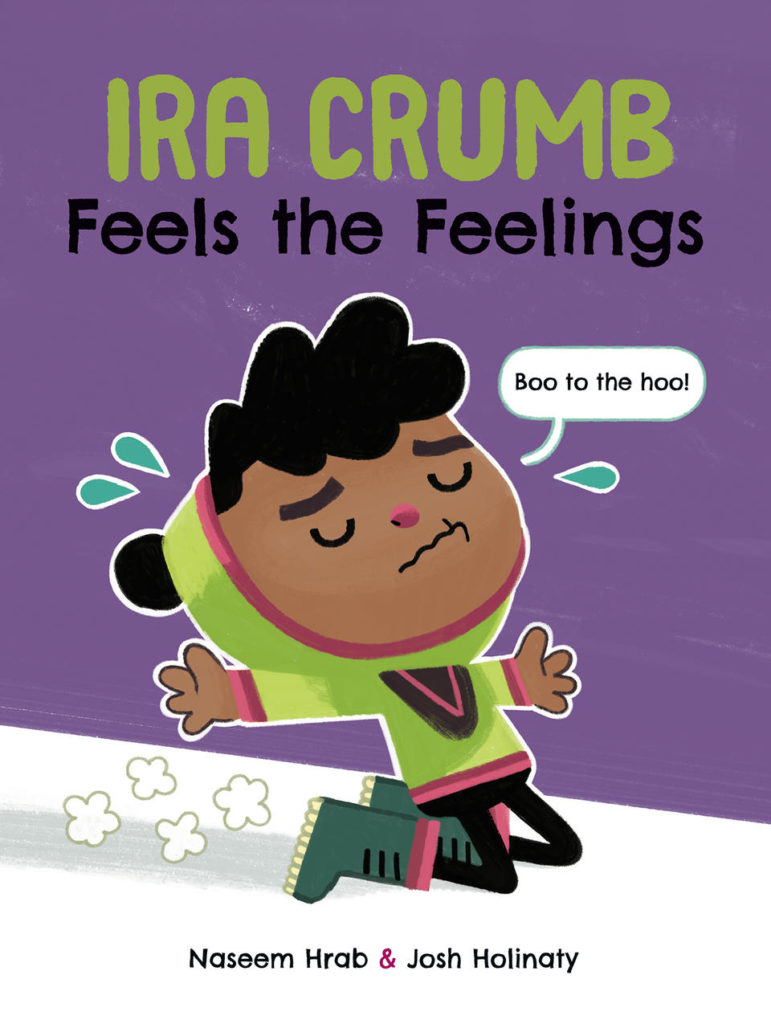
The children went back to school this week, and nobody cried—except me when they played “We Are Going to Be Friends” on the radio, but I’m not counting that. And while there is nothing wrong with crying, that nobody did cry means that this week has been relatively smooth sailing, so far. (Lack of sleep notwithstanding. ASBWU! [Always Somebody Be Waking Up!, possibly our new family motto]) But in Naseem Hrab’s Ira Crumb Feels the Feelings, illustrated by Josh Holinaty, things are just a little more emotional…
(Psst: see Hrab’s ‘An Open Letter to the Stranger Who Asked Me, “How Did You Write That Book for Children If You Don’t Have Children?”’)
This is Hrab and Holinaty’s second book about Ira Crumb, whose best friend is Malcolm Cake, who appears to be a rabbit. And they have a good time together and indulge in extra pickles, and everything is perfect until a little rift because Malcolm wants to play tag and Ira doesn’t, and finally Ira ends up alone. And not just alone: sad and alone.
“My tummy hurts,” says Ira, in comics-inspired speech bubbles. “My chin is wobbling. My eyes are leaking. Even my feelings are having feelings.”
This is a great book about emotions and the importance of feeling your feelings, but it’s also really fun to read with lots of deadpan humour, great pace and rhythm, and an anthropomorphic fart, of curse. The latter point meaning that the children really like it, but the really important part is that their parents like it too.
September 6, 2018
In Love with Lane Winslow

If you’ll recall, I did it wrong and read It Begins in Betrayal, by Iona Whishaw, last spring, having not yet read the previous three books in her Lane Winslow Mystery Series, but maybe it didn’t even matter, because I fell totally in love with the book, its characters, and Iona Whishaw’s fictional world, and the idea that I had three more books in the series to go back and discover was the very best news, and so I made this my summer project. So in June, I went back to the start and read A Killer in King’s Cove, about Lane Winslow’s arrival in the rural BC town after heartbreaking and dangerous experiences during World War Two, in which she’d served her country as a spy. But if quiet is what she’s seeking, Lane finds very little of it in her new life, where she is conspicuous as a young and very pretty woman who’s unattached and likes living alone. It doesn’t help either that dead bodies keep coming her way—and in the first book, it’s a body that’s washed up in her creek. When the local constabulary arrives, Lane herself becomes a suspect, her conspicuousness only underlined by the fact she cannot disclose much about her background and she seems to have an uncanny knowledge about things that are inappropriate for women to be concerning themselves with. And it’s here where Lane’s relationship with the dashing Inspector Darling is first sparked, but it takes until the end of Book 3 for both of them to realize and admit it.
I took Book 2, Death in a Darkening Mist, on vacation in July—body turns up in a hot springs, and there’s a whole Soviet spy plot—and it proved a most excellent companion. I read it very quickly, and continued to delight in the novel’s polish and smarts, and that the feminist threads I’d see in It Begins in Betrayal are woven all the way through. And finally, I read Book 3, An Old Cold Grave, this weekend, where the body turns up this time in a root cellar, and it’s a beautiful novel whose ties go back to British Home Children and their exploitation, but it’s also about women’s emancipation and independence from their fathers and husbands, and the terms under which Lane and Darling are going have a relationship—if one is finally going to happen.
So I’m all caught up, but it’s not over yet, oh no! Because this month A Sorrowful Sanctuary arrives, a mystery that explores Canada’s ties to Nazism, and I’ve read enough to know I’m probably good to have really high expectations. I’m looking forward to reading this one, and in the meantime, I’d encourage anyone—particularly those with a penchant for British cozy mysteries and detective fiction with excellent female characters—to pick up the preceding novels in the series. Iona Whishaw’s books have been the highlight of my reading year.
September 4, 2018
New Leaf
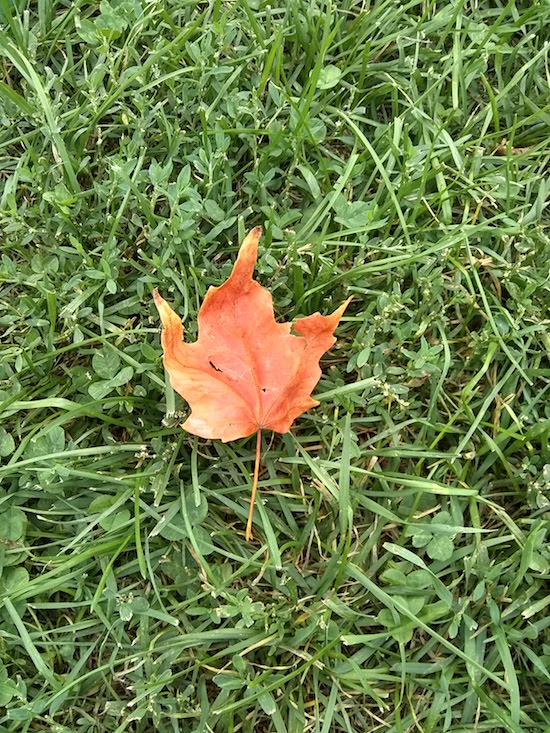
But as much as I love summer, I’m not sorry to see September at all. I’m happy to get my workdays back, for life to rediscover balance. My room is tidy for the first time in months, and yesterday I found a little bookshelf on the curb with which to organize the avalanche on my bedside table. I have no doubt that this little shelf will change my life, which is the kind of thought I often have in Septembers. This will be year I get it right, and not least of all because of my cool slouchy Cotton Ginny top. Obviously, of course, those were the September thoughts of a few decades ago. But still, the sentiment is the same.
This September is all about new beginnings, and also (I hope!) endings too, as I finally finish the first draft of my new novel, still untitled. It’s about taking the lessons of summer’s freedom with me into the new school year and making the most of the time I have to work while my children are at school. It’s also about serious reading as the evening belong to books again, and it is my best intention (although it always is) not to fritter it away on internet excess. I want to use my phone less while I am at home, keeping it in a fixed place in the house instead of always within arm’s reach. And I want to be more deliberate about the way I use social media too, visiting these sites just once or twice a day, when I have something to post even, and not just because I’m bored and require a distraction. I already don’t have Twitter and Facebook on my phone, so it’s not the world’s hugest problem, but I want to become more active as a user of these sites, instead of just passively scrolling along. And no phones at dinner. I don’t care what your excuse is. Or that the excuse is always mine.
September 3, 2018
Summerlong
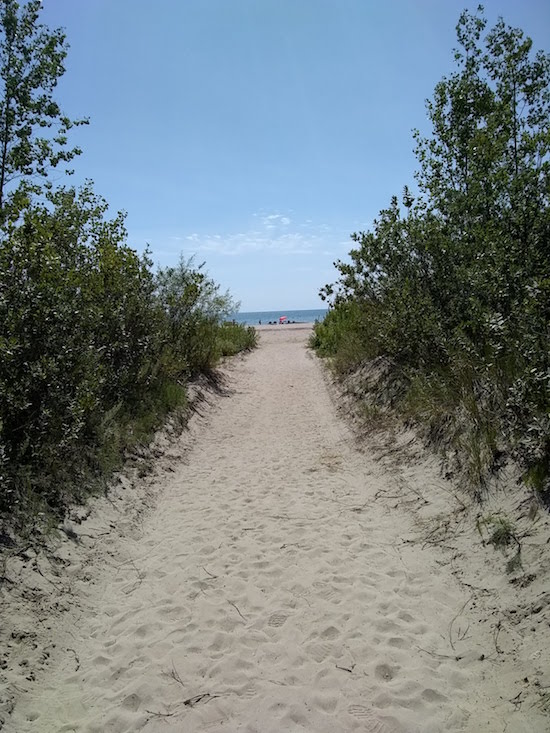
I love summer. I love it. I love popsicles and pools and eating dinner outside in the shade of umbrellas. I love the buzz of cicadas, the flash of butterflies, and the birds that start chirping before the sun comes up. Even if they wake me up before the sun comes up, and I even love the heat. Or maybe I mean I don’t mind hating the heat, because if ever there was a thing to suffer through. Treatable with long saunters through the frozen food section at the grocery store, whole weeks without turning the oven on, and by jumping into pools whose hours have been extended late into the night.
We have had a beautiful summer. (I think I write this every year, but it feels incredible and novel every single time. A triumph.) We had a wonderful week at a cottage by a lake with friends who make our life so rich, and our kids were kept entertained and stimulated at daycamps they both enjoyed so much. We went camping twice this year, which is a very big deal for us, and there were marshmallows roasted and wildflowers spotted and stoned skipped twice in the water. We spent a week in Peterborough with my parents, and there were turtles and crafts and voyageur canoes. We went on adventures around our city and went to events at the library, dipped our feet in wading pools, hung upside down on the climbing bars, and raced through the freezing relief of fountains at the splash-pad.
There was ice cream, and popsicles, and walks home from the grocery store where we had to run so the contents wouldn’t melt. My basil plant became enormous. I read extraordinary books. We went to shows at Fringe TO and saw Midsummer Night’s Dream in High Park, which delighted everybody. We went on car rides with the windows wide, and listened to Carly Rae Jepsen, Taylor Swift’s “Delicate” and “Strangers” by Sigrid. We went to the ROM, the AGO and the Textile Museum. We went swimming in lakes, pools, a quarry and a river. We had to shake sand out of everything numerous times. There was a rainbow at least once, and everybody got better at swimming. The Christie Pits waterslide was aways an adventure. We saw a meteor shower and fireflies.
And it was precious, all of it. Because summer is abundance, a wave of too-muchness, life growing up between the cracks in the sidewalk, and you can’t hold any of it, not even for a moment. Summer is a force and it just goes and goes and goes, and the best thing you can do is just be swept along by it, and be able to say in the end: we are so lucky and that was good.
September 1, 2018
T is for Tugboat

When Harriet was nearly two, I was inspired to begin recreating images from Allan Moak’s iconic Toronto alphabet book A Big City ABC, and thus Harriet’s Big City Alphabet was born! Born—but then left incomplete for five whole years. The most recent post was B is for Baseball in 2013. But then today we found ourselves at Hanlan’s Point, and finally we could get the shot for T is for Tugboat! Harriet is a thousand feet taller and she’s got a little sister now who’s no slouch either. And maybe now we should look into finishing the alphabet, because obviously it’s never too late.
